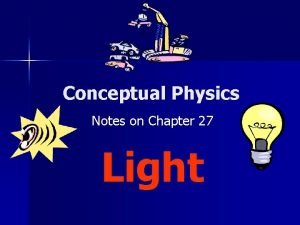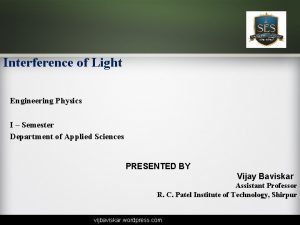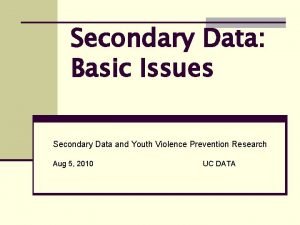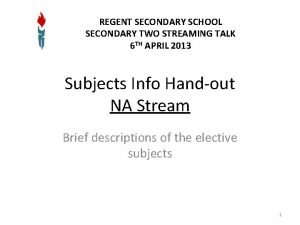LIGHT SECONDARY 3 PHYSICS What is Light Light












- Slides: 12

LIGHT SECONDARY 3 PHYSICS

What is Light? • Light is the part of the EM spectrum which we can see. • Light travels in straight lines called rays. • A bundle of rays is known as a beam of light. A ray A parallel beam A divergent beam A convergent beam

Reflection • Reflection is the bouncing of light rays off a surface. • We are able to see non-luminous objects as light is reflected off them.

Reflection normal Incident ray Angle of incidence, i surface Angle of reflection, r Reflected ray

Laws of Reflection • The incident ray, the reflected ray and the normal all lie on the same plane. • The angle of incidence is equal to the angle of reflection.

Properties of Image Formed by Plane Mirror • Same size as the object • Laterally inverted (left-to-right inversion) • Upright • Virtual (image cannot be caught on a screen) • Object distance is equal to image distance

Ray Diagram for Reflection Object, O observer

Ray Diagram for Reflection Object, O observer Image, I

Refraction • Refraction is the bending of light when it enters from one transparent medium into another. • It is caused by the different speeds of light in different media. • The greater the optical density of the medium, the slower the speed of light.

Refraction Incident ray Angle of incidence Angle of refraction Refracted ray Angle of emergenc e normal Emergent ray

Daily Phenomena of Refraction • Swimming pool and ponds appear shallower than it really is. • Object is at a deeper depth than where it appears to be. • Bent objects in liquids

Total Internal Reflection • Light ray is unable to exit a medium. • This means it will continue to bounce around until the angle of the medium boundary is changed.
 Light light light chapter 23
Light light light chapter 23 Into the light chapter 22
Into the light chapter 22 Light light light chapter 22
Light light light chapter 22 Modern physics vs classical physics
Modern physics vs classical physics University physics with modern physics fifteenth edition
University physics with modern physics fifteenth edition Physics ib ia ideas
Physics ib ia ideas Primary and secondary source of light
Primary and secondary source of light Primary source of light is
Primary source of light is Conceptual physics chapter 27 light pdf
Conceptual physics chapter 27 light pdf Interference of light engineering physics
Interference of light engineering physics Othello put out the light
Othello put out the light Difference between light dependent and light independent
Difference between light dependent and light independent Bouncing off of light
Bouncing off of light























